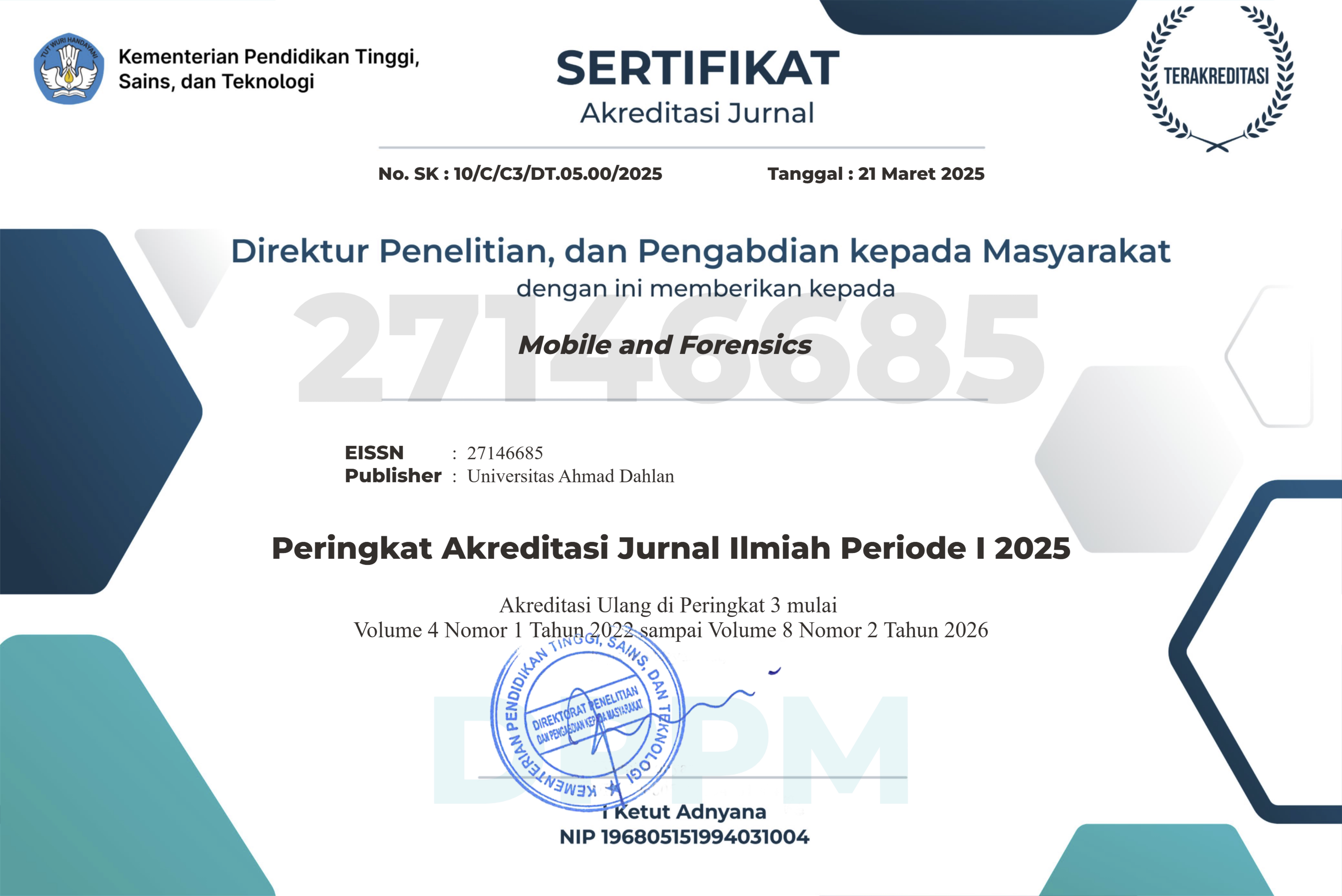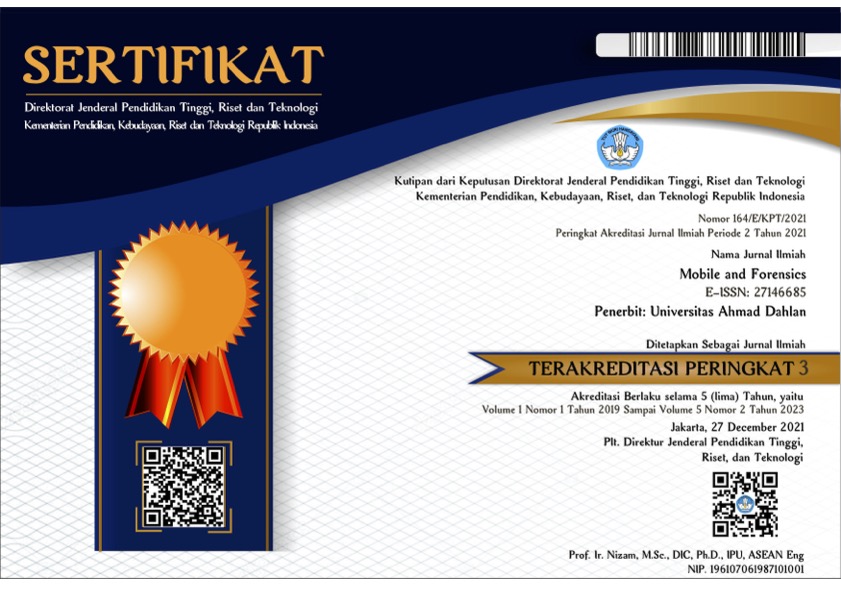Image Forensics Using Error Level Analysis and Block Matching Methods
DOI:
https://doi.org/10.12928/mf.v6i2.5719Keywords:
Block Matching, ELA, Forensics Image, Eror LevelAbstract
The development of image editing tools today makes everyone able to manipulate images easily so that many images are doubtful of their authenticity. The current image can be used as evidence in a legal case in court. The authenticity of the image is a topic that many have tried to solve various studies. This study discusses the authenticity of the image using the Error Level Analysis (ELA) method to determine the authenticity of the image, especially in the JPEG image. Block Matching is used in the process of dividing an image into several square or block parts. The ELA method has been successfully implemented with 95% image compression resulting in MSE and PSNR values in distinguishing the edited image. The average MSE is 23.8 dB and the average PSNR is 34.47 dB. Block Matching results as a whole show that the pixel value for x values that reach 30 there are 9 images, x values that reach 24 there are 9 images, x values that reach 23 there are 1 image, and for x values that reach 19 there is 1 image. The result of pixel (y) of all images exceeds the value of 12 which in pixel (y) undergoes many changes marked by the presence of white spots.
References
A. Shatté, A. Perlman, B. Smith, and W. D. Lynch, ‘The Positive Effect of Resilience on Stress and Business Outcomes in Difficult Work Environments’, J. Occup. Environ. Med., 2017, doi: 10.1097/JOM.0000000000000914.
J. Lin, W. Yu, N. Zhang, X. Yang, H. Zhang, and W. Zhao, ‘A Survey on Internet of Things: Architecture, Enabling Technologies, Security and Privacy, and Applications’, IEEE Internet Things J., 2017, doi: 10.1109/JIOT.2017.2683200.
G. K. Birajdar and V. H. Mankar, ‘Digital image forgery detection using passive techniques: A survey’, Digital Investigation. 2013. doi: 10.1016/j.diin.2013.04.007.
A. N. Katsaounidou, A. Gardikiotis, N. Tsipas, and C. A. Dimoulas, ‘News authentication and tampered images: evaluating the photo-truth impact through image verification algorithms’, Heliyon, 2020, doi: 10.1016/j.heliyon.2020.e05808.
K. Shu, A. Sliva, S. Wang, J. Tang, and H. Liu, ‘Fake News Detection on Social Media’, ACM SIGKDD Explor. Newsl., 2017, doi: 10.1145/3137597.3137600.
L. Zheng, Y. Zhang, and V. L. L. Thing, ‘A survey on image tampering and its detection in real-world photos’, J. Vis. Commun. Image Represent., 2019, doi: 10.1016/j.jvcir.2018.12.022.
N. Chebib and R. M. Sohail, ‘The Reasons social media contributed to 2011 Egyptian Revolution’, Int. J. Bus. Res. Manag., 2011.
N. S. Love, C. Kamath, Q. L. Q. Luo, and T. M. Khoshgoftaar, ‘An Empirical Study of Block Matching Techniques for the Detection of Moving Objects Block Matching Techniques’, 2007 IEEE Int. Conf. Inf. Reuse Integr., 2006.
J. Ma, X. Jiang, A. Fan, J. Jiang, and J. Yan, ‘Image Matching from Handcrafted to Deep Features: A Survey’, Int. J. Comput. Vis., 2021, doi: 10.1007/s11263-020-01359-2.
D. Honzátko and M. Kruliš, ‘Accelerating block-matching and 3D filtering method for image denoising on GPUs’, J. Real-Time Image Process., 2019, doi: 10.1007/s11554-017-0737-9.
I. Gede Nengah Bayu Darmawan, G. Made Arya Sasmita, and P. Wira Buana, ‘Pengembangan Metode Pendeteksi Modifikasi Citra Menggunakan Metode Error Level Analysis’, J. Ilm. Merpati (Menara Penelit. Akad. Teknol. Informasi), 2019, doi: 10.24843/jim.2019.v07.i01.p04.
H. Bisri and M. I. Marzuki, ‘Forensik Citra Digital Menggunakan Metode Error Level Analysis, Clone Detection dan Exif Untuk Deteksi Keaslian Gambar’, G-Tech J. Teknol. Terap., 2023, doi: 10.33379/gtech.v7i2.2363.
I. Riadi, A. Yudhana, and W. Y. Sulistyo, ‘Analisis Image Forensics Untuk Mendeteksi Pemalsuan Foto Digital’, Mob. Forensics, vol. 1, no. 1, p. 13, Sep. 2019, doi: 10.12928/mf.v1i1.703.
A. Y. Wijaya, S. Al Musayyab, and H. Studiawan, ‘PENGEMBANGAN METODE BLOCK MATCHING UNTUK DETEKSI COPY-MOVE PADA PEMALSUAN CITRA’, JUTI J. Ilm. Teknol. Inf., vol. 15, no. 1, p. 84, Jan. 2017, doi: 10.12962/j24068535.v15i1.a638.
S. Ferreira, M. Antunes, and M. E. Correia, ‘Exposing manipulated photos and videos in digital forensics analysis’, J. Imaging, 2021, doi: 10.3390/jimaging7070102.
R. Maini and S. Mehra, ‘A Review on JPEG2000 Image Compression’, Int. J. Comput. Appl., 2010, doi: 10.5120/1607-2159.
Y. Lai, T. Huang, J. Lin, and H. Lu, ‘An improved block-based matching algorithm of copy-move forgery detection’, Multimed. Tools Appl., 2018, doi: 10.1007/s11042-017-5094-y.
G. Peterson, ‘Forensic Analysis of Digital Image Tampering’, in Advances in Digital Forensics, Boston: Kluwer Academic Publishers, pp. 259–270. doi: 10.1007/0-387-31163-7_21.
Nurhidayah, B. Abdul Samad, and B. Abdullah, ‘Perbandingan Metode Contrast Enhancement pada Citra CT-Scan Kanker Paru-paru’, Gravitasi, vol. 19, no. 2, pp. 24–28, Dec. 2020, doi: 10.22487/gravitasi.v19i2.15360.
H. Lee, J. Lee, H. Kim, B. Cho, and S. Cho, ‘Deep-neural-network-based sinogram synthesis for sparse-view CT image reconstruction’, IEEE Trans. Radiat. Plasma Med. Sci., 2019, doi: 10.1109/TRPMS.2018.2867611.

Downloads
Published
Issue
Section
License
Copyright (c) 2024 Iis Sudianto, Nuril Anwar

This work is licensed under a Creative Commons Attribution-ShareAlike 4.0 International License.
Start from 2019 issues, authors who publish with JURNAL MOBILE AND FORENSICS agree to the following terms:
- Authors retain copyright and grant the journal right of first publication with the work simultaneously licensed under a Creative Commons Attribution License (CC BY-SA 4.0) that allows others to share the work with an acknowledgment of the work's authorship and initial publication in this journal.
- Authors are able to enter into separate, additional contractual arrangements for the non-exclusive distribution of the journal's published version of the work (e.g., post it to an institutional repository or publish it in a book), with an acknowledgment of its initial publication in this journal.
- Authors are permitted and encouraged to post their work online (e.g., in institutional repositories or on their website) prior to and during the submission process, as it can lead to productive exchanges, as well as earlier and greater citation of published work.

This work is licensed under a Creative Commons Attribution-ShareAlike 4.0 International License.












 Mobile and Forensics (MF)
Mobile and Forensics (MF)